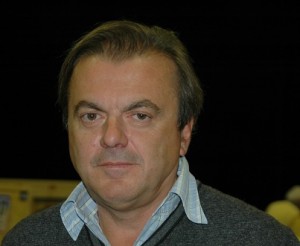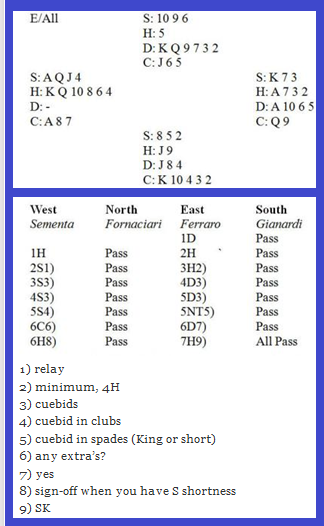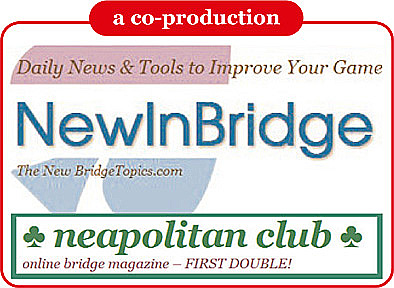 Guido Ferraro is best known as one of the star players in the world of bridge. His career started in the 1980s, when he already was one of the best European juniors. With Giorgio Duboin he won the European Junior Pairs and from then on his career went big, including winning world titles. Less known is his role as an administrator. Recently he was elected in the new federal committee of the Italian Bridge Federation. And last week he won the Italian Club Team Championships playing for Lavazza. All good reasons for Laura Camponeschi, the Italian correspondent of NewInBridge and blog-owner of Neapolitan Club, to make an interview with Ferraro.
Guido Ferraro is best known as one of the star players in the world of bridge. His career started in the 1980s, when he already was one of the best European juniors. With Giorgio Duboin he won the European Junior Pairs and from then on his career went big, including winning world titles. Less known is his role as an administrator. Recently he was elected in the new federal committee of the Italian Bridge Federation. And last week he won the Italian Club Team Championships playing for Lavazza. All good reasons for Laura Camponeschi, the Italian correspondent of NewInBridge and blog-owner of Neapolitan Club, to make an interview with Ferraro.
LC: You are a professional bridge player and we know that you love playing golf. Do you have other interests?
Guido Ferraro: I love history, in particular history of medieval church and popes. I have always been interested in history of the Catari people. I feel that I share a lot with their heresy and view of religion.
LC: And what about your private life?
GF: I have been married for 25 years and I am faithful.
LC: Having won the European Championships in Ostend Italy was not able to repeat that success in Dublin and content itself with the bronze in medal. The Veldhoven Bermuda Bowl was the same story: bronze. In Lille it was even worse. In spite of the great Italian victory record in the Olympics (nowadays the World Mind Sports Games) we did not even make the podium. What could be the reason for this fall?
GF: We could call it a wearing of the team. We struggle a bit more than we used to because our team gets older, while others improve. There are strong young teams emerging around, and we need to deal with them. It is not the case that we are less strong, rather the others are getting better. We cannot rely on the certainty to win anymore, as we used to do.
LC: What can be done to bring the Blue Team back to the top of international bridge?
GF: Italy is at the top of international bridge and will stay there.
LC: To what extent does the Fantunes issue affect Italian bridge? With “Fantunes issue” we refer to their exclusion from the Italian national team in Ostend 2010, and their decision to accept Zimmermann’s offer and thus to represent Monaco.
GF: I personally do not miss Fantunes. And many agree with me. I think Claudio and Fulvio did well to move to Monaco, in order to boost they international visibility. Their choice is good both for bridge and for money. To sum up, they are not essential to the Italian team, so they did well to accept Monaco’s offer. If they had decided to wait to come back to the Italian team, they would have risked to wait 4 or 5 years, but the visibility a national team gives you is too important for professional players. I am sure this was not a light-hearted decision, knowing that they have no chances to come back to Italy soon. I agree with their choice. I do not sigh for them, but I respect the choices one makes to protect his economical life.
LC: The European Bridge League changed the eligibility code in time for the last European Championships in Dublin. This allowed Zimmermann’s team to represent Monaco. What is your opinion about Zimmermann’s project?
GF: Call me naïve, but I do not think the change has been done to do Zimmermann a favor. Rather it has been the choice of some players to represent Monaco that raised the issue for the EBL. Let’s look at it from another perspective: not letting them play would have been a way to punish Nunes, Fantoni, and the other players. May be bridge should adapt the Bosman case indeed. [editor: the famous Bosman case is about the fact that sometimes the rights of soccer players are more important then International League Rules]
I think everyone should be allowed to choose the country he wants to represent, even though I think this choice should be final and irreversible.
We have to allow only one migration, and I think the WBF and EBL agree with this view, so it is very unlikely that we will see Fantunes again in the Italian team. Had I been in the EBL committee who had to decide the eligibility criteria, I would have voted in favor of accepting Zimmermann’s team, and happily so. If the EBL and WBF decide to let Fantunes change country again, I will think this is inappropriate and disagree with a seemingly tailor-made decision.
LC: The International Bridge Press Association (IBPA) assigned Maria Teresa Lavazza the prestigious Bridge Personality of the Year 2012 Award. The IBPA and other media made the news public and congratulated the winner. On the other hand the Italian Bridge Federation seems to have missed this completely. Moreover, when Maria Teresa Lavazza resigned from the role as team selector, the Federation did not thank her at all. The world places Maria Teresa Lavazza in the Hall of Fame and our Federation does not even thank her for the efforts to resurrect the legendary Blue Team. As member of the Italian Federal Committee of FIGB (Italian Federation) can you please explain this?
GF: As you know the Italian Federation for two years has been put under curatorship by an emergency commissioner and a substitute of the Italian Olympic Committee. They did not show any ability to connect people within the federation, and to show any sensitivity to such events. It was a very difficult situation and in the process of moving from the old to the new committee. Anyway, to be honest, we are responsible of forgetting this. I feel guilty for not thinking about this when the new committee was elected. I do not think there was any real intention to hide the prize Maria Teresa Lavazza was given by the IBPA. The new committee thinks highly of her and I can assure you that new President, Mr Medugno, would like her to stay as captain of the Open team. In the next committee meeting I will suggest to make things right and highlight the award. In general I can tell you that the political and economical situation inherited by the new committee is such that it will take some time to solve past disasters.
LC: Usually in December the tournament “Città di Milano” takes place. This is the most important Italian teams event and one of the most famous in Europe. However, it has not been scheduled yet for this year. What is happening? After Venice and Naples are we going to lose Milan as well?
GF: Giancarlo Bernasconi has been organizing this competition for many years. However he has been upset by the behavior of several persons – also by my side probably – during the elections. [Editor: Mr Giancarlo Bernasconi was one of the candidates for President of the Italian Federation and was at first supported by GF. Later GF supported another candidate.] The issues related to the campaign and the election of the new committee made him lose passion and interest in bridge. Right now it looks like Bernasconi does not want to organize the tournament and without him it is much harder. Certainly the organizational process is late and we are looking for sponsors. I have been given the task to deal with this by the new president of the Italian Federation, Gianni Medugno, who is trying to save the tournament in any possible way. Basically we will manage to save it is we find some sponsors. Actually I am fairly optimistic.
LC: Would you like to make an update of our three open national pairs: Lauria-Versace, Bocchi-Madala, Duboin-Sementa?
GF: Lauria and Versace make a very strong pair, however they have been playing for a long time and sometimes wine becomes vinegar. They used to overcome tough moments with style and desire to play. Now it looks to me that they still have their style, but less willing to play.
Bocchi-Madala is a new pair which will certainly improve. They will soon be amongst the best in the world.
As to Duboin and Sementa: they are not matching. Individually taken they are great players, but the do not gel. And they are amongst the first ones to confirm.
LC: For what concerns Sementa, you played with him in one round of the last Club Championships, during the final against Fornaciari – Gianardi (Reggio Emilia). NIB’s Jan van Cleeff published at NIB (NewInBridge) an article about your bidding which he thinks is candidate to the best bidding award.

GF: Sadly it is not the bidding of the year, because I bid one round too much. Until 5S and 5NT it is fine. However after Sementa’s 6C I should have bid 7H straight away. Instead I bid 6D, thus generating an unnecessary sequence, due to my old habits of being extra safe. When my partner bid 6H I realized what was happening and bid 7. Luckily Sementa is a very quick player and did not hesitate before bidding 6H. If he did, the opponents would have called for the director! The hesitation could be interpreted as a signal and would have put me in an awkward position. My 6D is not only an extra bid, but runs the risk of creating problems if partner thinks before bidding 6H. So, I say it again, I should have bid 7H immediately. This bidding is beautiful but not perfect.
LC: Will we see Sementa-Ferraro again?
GF: Yes, we will play together in the pairs at the Cavendish.
LC: A question about the new VP scales, announced by the WBF. It raised doubts and debate amongst experts and players. What do you think?
GF: I wonder if a golf player came up with it! I think you either win or lose 2:0. I never had sympathy for wide ranging scales. At the very best it should end 4:0. I have been complaining about this for 20 years, because it turns out that to win a tournament you have to beat up the weak teams 25:0 and try to limit the damage from the stronger teams. If victory gave a team 2 or 4 points then the strategy would be different. The proposed change seems to be a repetition: the scale should be made less wide ranging and not the other way around. An unnecessary reform.
LC: We always finish our interviews with some technical questions. I have three bridge questions for you. First: what do you think of 10-12 NT?
GF: It’s a f*** convention!
LC: And what do you think of weak NT (12-14) vulnerable, played by Fantoni and Nunes?
GF: The problem lies in the structure. Their system makes weak NT necessary. Let me explain: to make the system coherent they had to open weak NT all hands not covered by the other opening bids. This is why they open 1NT not only balanced hands but also 5422s and other peculiar hands. How can I say it better? They use the 1NT opening as the dust bin for all hands that they could not open otherwise. This is a solution that solves many problems and gives good information in defense. I think the Fantunes system is really good and stems from a philosophical, so to say, choice which has many positive and very few negative features.
LC: Second technical question: with which kind of hand do you overcall after they open strong club? Some argue that with a 5332 shape, even strong in HCPs, it is best to pass. Do you agree?
GF: I look more at the quality of the suit, rather than shape. If I have 11 points with five spades to the 10 I would not overcall, but if I have 7 points with KQJT9 of spades I would overcall two spades, lying on the length of the suit. My overcalls at the one level are mostly lead directing. With queen to five spades and 12 points to be honest I would rather pass.
LC: Do you like to hide the suit with artificial overcalls over strong club, so that the suit is not immediately known, in order to avoid a penalty double?
GF: In modern bridge it is generally better to overcall. Nowadays they open strong club even with 15 points and a seven-card suit, so if you do not bid you run the risk to miss a game. It is better to overcall. But if you talk about delayed overcall (bidding the suit second time round) I answer with a joke: a delayed overcall is done by a “delayed player”!
LC: Third and last bridge question. Giorgio Belladonna wrote that he learned how to reconstruct hidden hands by following Adolfo Giannuzzi’s suggestions in his book “Squeezes in bridge”, written in the 40’s. What would you recommend to someone who wants to improve in this respect?
GF:To read Giannuzzi’s book!
LC:Did you read it?
GF: I still have it in my library, I read it more than twenty years ago.
LC: What countries are improving at the moment and which are getting worse?
GF (smiling ear to ear): Italy and…Italy!
***
Laura Camponeschi [translated by Laura Cecilia Porro for Neapolitan Club]
October 5, 2012
